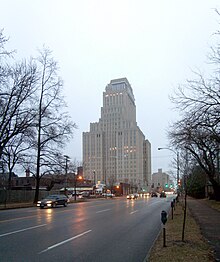Chase Park Plaza Hotel
| The Chase Park Plaza Royal Sonesta St. Louis | |
|---|---|
 The original Chase wing | |
Location of Chase Park Plaza Hotel in St. Louis | |
| General information | |
| Location | St. Louis, Missouri, U.S. |
| Address | 212 North Kingshighway Boulevard, St. Louis, Missouri |
| Coordinates | 38°38′39″N 90°15′50″W / 38.64417°N 90.26389°W |
| Opening | September 29, 1922 |
| Management | Sonesta Hotels |
| Technical details | |
| Floor count | 28 |
| Design and construction | |
| Architect(s) | Preston J. Bradshaw |
| Other information | |
| Public transit access | |
The Chase Park Plaza Royal Sonesta St. Louis is a historic hotel and apartment complex located at 212 N. Kingshighway Boulevard in the Central West End of St. Louis, Missouri. It consists of two buildings - the Chase Hotel, built in 1922 by developer Chase Ullman,[1] and the Art Deco-style Park Plaza tower, built in 1929 and today housing condominiums. The complex also features a cinema and several restaurants and bars.[2]
History
[edit]The Chase replaced the nearby Buckingham Hotel as the most luxurious hotel in the city. The ground-floor Chase Club was a popular venue for nationally known entertainers from its opening in 1933 until it was closed in 1972.
In 1929, seven years after the Chase's opening, the rival Park Plaza was built next door. The Park Plaza's original owner, Sam Koplar, lost the Park Plaza to foreclosure during the Great Depression, but regained ownership in 1944; he became the Chase's majority owner in 1946.
The two hotels merged into the Chase-Park Plaza in 1961.[3] The Park Plaza later was converted to apartments and now is a condominium complex.
From 1989 to 1999, the Chase wing was closed. After the hotel reopened, the hyphen was dropped from the name and the property is now known as the Chase Park Plaza.
The hotel joined the Sonesta hotels chain on May 18, 2017.[4] The Chase Park Plaza is part of the National Trust for Historic Preservation's Historic Hotels of America program.
Jackie Robinson and desegregation
[edit]
Jackie Robinson was a Major League Baseball (MLB) second baseman who became the first African American to play in the major leagues in the modern era. Robinson broke the baseball color line when the Brooklyn Dodgers started him at first base on April 15, 1947.[5]
In 1953, Robinson openly criticized segregated hotels and restaurants that served the Dodger organization. A number of these establishments integrated as a result, including the Chase Hotel.[6][7]
Wrestling at the Chase
[edit]The Chase was also famous for hosting a wrestling program called Wrestling at the Chase (1959–1983),[8][9] produced and televised by KPLR-TV channel 11, whose operations were in the hotel and the adjoining Park Plaza apartments, all owned by Harold Koplar, Sam Koplar's son. Many famous wrestlers, including St. Louis native Lou Thesz and Buddy Rogers, wrestled on the program.
See also
[edit]References
[edit]- ^ "Historic Hotels of America | Historic Hotels USA | Historic Hotel".
- ^ O'Connor, Candace (2005). Meet Me in the Lobby: the Story of Harold Koplar and the Chase Park Plaza. St. Louis: Virginia Publishing Co. ISBN 1-891442-32-5.
- ^ "Lost Tables: The Chase Park Plaza".
- ^ "The Chase Park Plaza in St. Louis to Join Royal Sonesta Hotels".
- ^ Scott Simon, Jackie Robinson and the integration of baseball (2002).
- ^ Wormser, Richard (2002). "Jackie Robinson integrates Baseball". Public Broadcasting Service. Retrieved September 14, 2009.
- ^ Erskine, Carl with Burton Rocks (2005). "Wait Till Next Year". What I Learned from Jackie Robinson: A Teammate's Reflections On and Off the Field. New York: McGraw-Hill. pp. 61–74. ISBN 0-07-145085-8.
- ^ Hornbaker, Tim (2006). National Wrestling Alliance: The Untold Story of the Monopoly That Strangled Pro Wrestling. ECW Press. p. 55. ISBN 1-55022-741-6.
- ^ Matysik, Larry (2005). Wrestling at the Chase: The Inside Story of Sam Muchnick and the Legends of Professional Wrestling. ECW Press. p. 152. ISBN 1-55022-684-3.
External links
[edit]
- 1922 establishments in Missouri
- Architecture of St. Louis
- Hotels established in 1922
- Hotel buildings completed in 1922
- Hotel buildings completed in 1929
- Hotels in St. Louis
- Landmarks of St. Louis
- Skyscraper hotels in Missouri
- Skyscrapers in St. Louis
- Central West End, St. Louis
- Buildings and structures in St. Louis
- St. Louis geography stubs
- United States hotel stubs


